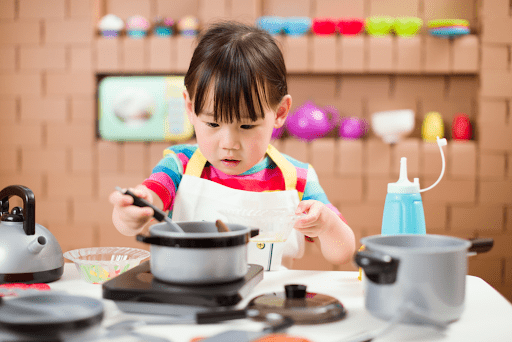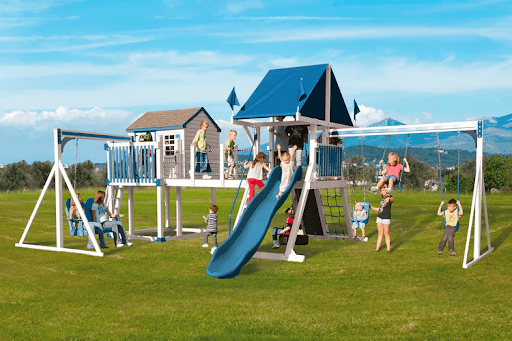Creativity In Children: Why It Matters & How You Can Nurture It

The idea of imagination in childhood brings up priceless memories for us all — times spent in the yard making up games with friends or indoors playing pretend. But most parents will notice as their child develops, that creative play is serious business and their child treats it as such. (Perhaps that’s why after a full day of new and satisfying play, bedtime often becomes easier.)
Creativity in children is something we admire. They take their limited observations and experiences, and often give us answers that are clever and demonstrate divergent thinking. However, it’s also clear if we look at the stages of early childhood development, creativity is an important piece in your child’s growth.
After this blog, you’ll better understand how creativity in children lines up with the development stages of early childhood, so you can foster the best environment for imagination to thrive. We’ll also give you some practical tips you can use at any stage to help encourage creativity in your child.
What Is Creative (or Imaginative) Play?
Creative (or imaginative) play is what happens when children use a familiar item or resource in a way that’s new to them or unusual from its intended purpose. As children engage in this type of behavior, it switches them into their imagination.
It’s also about more than having fun. Play is the vehicle children use to learn about the world around them and their place in it. Examples of creativity in early childhood can include activities like playing pretend with props, making art, making music, dancing, or inventing a new game.
But it can be subtle as well. Creativity doesn’t always equal something artistic. Your child is exercising creativity when they find a new way to build a block tower or complete a simple task too.
Imagination in childhood will look different for every child. And it’s best to allow your child to engage with creativity in a way that fits their natural curiosity and growth. Next, we’ll look at the stages of creative development in early childhood so you have an idea of how you can provide a nurturing environment that fosters your child as they grow.

How Does Creativity Fit Into Your Child’s Development?
There are five stages of development in children, and creative development is a catalyst for those skills your child is learning at each point. Below we’ll break down the five stages and what creativity in children looks like for each age range.
Newborn: 0-3 Months
At this stage, children are highly reactive to stimuli like light, noise, and temperature. They’re extremely dependent on caretakers and unable to do much without help.
What Does Play Look Like in This Stage?
They’re very dependent on their parents and the ability to play hasn’t emerged yet.
Infant: 3-12 Months
Children undergo a lot of rapid changes. First, young babies learn to sit up unsupported, how to recognize faces, and how to start babbling. Next, they develop neck strength, head control, and their reflexes as they reach out for toys.
Eventually, in the 6- to 9-month range, they start to recognize their own name, grow teeth, and eat food. Then by 9 to 12 months, they can play games like peek-a-boo and pick up items they’re interested in. Some babies will start to crawl and stand with some support. A few are even able to walk.
What Does Play Look Like in This Stage?
At this point, children can participate in ‘enactive naming,’ which simply means they can demonstrate the knowledge they’ve learned (such as copying a parent’s actions) but they can’t pretend yet. And even though children at this stage aren’t able to engage in imaginative play, this is the beginning that sets the stage for it.
Toddler: 1-3 Years
In this stage, you’ll see that toddlers start by standing unsupported and then gain better control of their fine motor skills. Eventually, they’ll climb and walk independently and be capable of speaking single words and simple sentences, as well as following instructions.
What Does Play Look Like in This Stage?
Toddlers are more active, so, naturally, their creative development takes this form. They enjoy active games and activities. You’ll also notice toddlers start to enjoy engaging in pretend play. They’ll also get excited about hands-on activities like using play dough or finger painting.
Preschooler: 3-5 Years
By this stage, children are becoming much more confident and refined in their abilities. From speech to mastering emotions and thinking, preschoolers can string together thoughts in more complex sentences and have reached an elevated level of play.
What Does Play Look Like in This Stage?
Preschoolers can now engage in dramatic play, which means they can better pretend to be something. Their imaginations are more developed, allowing them to express themselves more through activities like art, games, or dancing.
They are also going to mimic everyday activities they see around them in their play. For example, they’ll pretend they’re cooking in the playhouse outside or pretend to go ‘shopping’ at the grocery store.
School Age: 6+ Years
By this point, children are ready to be more independent in how they behave, act, and think. They can learn school skills quickly, express themselves with language, and begin to build friendships and participate in new experiences.
What Does Play Look Like in This Stage?
Play becomes a conceptual undertaking with lots of moving parts. Children start to imagine whole other worlds or storylines.
From imagining they’re the hero in a road race as they ride a pedal kart around the yard to sailing off to sea in a ship to search for treasure, they can build more complex narratives. And while it may just look like imagination, through this type of exploration your children are building their critical thinking skills, social skills, and so much more.

What Are The Benefits of Creative Play?
The positive effect of play supports many aspects of a child’s physical, emotional, and mental growth. Ultimately it’s how they learn and experiment with what they’re learning about the world around them.
Regardless of what stage or form of play they’re at, the benefits of imaginative play in early childhood are that it develops:
- Sensory skills
- Verbal storytelling skills
- Hand-eye coordination
- Attention span and concentration
- Social skills
- Problem-solving
- Individual confidence and self-esteem
- Comprehension of different environments
Now that you’ve learned more about each stage and can identify where your child falls, we’ll next look at how to set up the right environment to encourage your child’s creative play.
How To Encourage Creativity In Children in 4 Simple Steps
Before we get into recommendations, it’s key to remind yourself that no two children develop the same way, and that’s okay! Ultimately there’s a lot of advice out there for parents, but you know your child best. We encourage you to trust your gut and consider what you know will work best.
#1 Provide A Safe Space For Imagination
Indoors create an area your child can navigate and explore freely, so they can build up independence and drive their learning. This will ultimately help your child gain more self-confidence to continue growing into the next stage.
Don’t forget about the outdoors either! Having a safe and sturdy swing set or a highly-rated, safe-to-use trampoline with a net in your yard can provide hours of endless fun and adventure. It also means play can happen whenever your child wishes, as opposed to requiring a trip to the local playground or a friend’s house.
#2 Build Play Into Your Schedule
As a parent, you’ll eventually have a routine for your child from waking up in the morning until it’s time for bed. Don’t forget to add play to the mix!
It’s important to give your child the chance to engage in longer uninterrupted play sessions. Even if at the start they’re unsure of what to do, it’s a benefit for children to be bored and learn how to find their way into play.
#3 Create Opportunities For Socializing
It’s natural to want your child to become an empathetic and caring member of the community. And socialization with other children is the way to build that awareness and kindness toward others. Remember to plan playdates at your house or out around town with other kids your child can play with.
#4 Stay Flexible
Comparison of pressure will take the fun out of play. Remember to not fall into the trap of labeling your child as creative or uncreative — it takes many different forms across adults and the same can be said for children.
Simply enjoy watching your child learn and provide them with an environment that helps them explore what excites them. If you focus on doing that, you’ll have done a great job encouraging creativity in your child.




